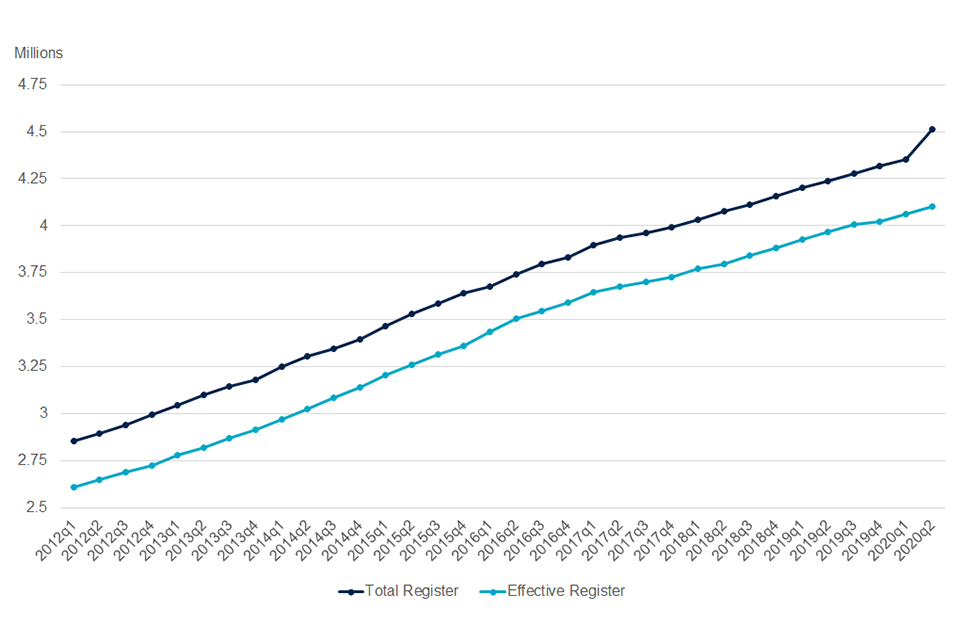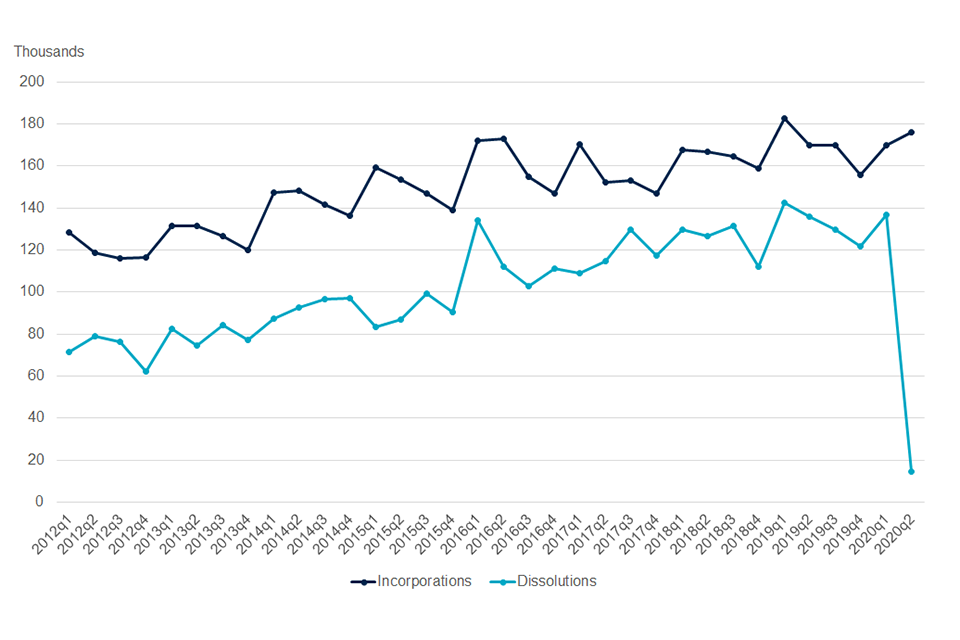Incorporated companies in the UK April to June 2020
Updated 24 June 2021
This release provides information about the population of companies in the UK. A company is defined as a specific legal form of business formed under the Companies Act 2006. Companies are registered at Companies House regardless of whether they go on to trade actively. Further information on companies and the Companies Act 2006 is provided in the document Definitions to accompany statistical releases.
The statistics in this release include the total number of incorporated companies, the number of newly incorporated companies and the number of companies that were dissolved. The release focusses on the headline messages for the UK. Figures for the constituent countries are contained in the supplementary tables that accompany this release. The supplementary tables also contain separate figures for public companies and limited liability partnerships.
Key points
-
In response to the coronavirus (COVID-19) outbreak, a set of easements were announced by Companies House on 16 April 2020. They included the temporary pause of the strike off process to give businesses affected by the coronavirus outbreak the time they need to update their records filed with Companies House and help them avoid being struck off the register. The impact of this announcement was that compulsory dissolutions from 2 April onwards were temporarily paused. For this reason, the number of dissolutions in the second quarter of the year were significantly less than would usually be expected. The number of companies in the course of removal has conversely increased for the same reason.
-
At the end of June 2020, there were 4,513,392 companies on the total register and 4,100,323 on the effective register. The total register size saw a sharp increase in the second quarter of 2020. This was partly as a result of the set of easements announced by Companies House on the 16th April 2020 and coincides with the coronavirus (COVID-19) pandemic.
-
Between April and June 2020, there were 176,115 new incorporations and 14,606 dissolutions in the UK. The low number of dissolutions was as a result of the easements introduced.
-
The number of incorporations in the second quarter of 2020 increased by 6,139 (3.6%) compared with the same quarter of the previous year. This is the largest quarter 2 year on year increase since 2012.
-
The number of dissolutions in the second quarter of 2020 decreased by 121,264 (89.3%) compared with the second quarter of 2019. Conversely, the number of companies in the course of removal increased by 137,180 (74.9%) over the same period. This was due to the set of easements announced on 16th April 2020.
-
In contrast to trends in previous years, the number of incorporations in the second quarter of 2020 were higher when compared with the first quarter of 2020.
Incorporated companies
At the end of June 2020, there were 4,513,392 companies on the UK total register – this includes those in the course of dissolution and liquidation (413,069).
Between April and June 2020, there were 176,115 incorporations and 14,606 dissolutions in the UK. The figures were impacted by a set of easements announced by Companies House on 16 April 2020 in response to the coronavirus (COVID-19) outbreak. These included the temporary pause of the strike off process to give businesses affected by the coronavirus outbreak the time they need to update their records filed with Companies House and help them avoid being struck off the register. The impact of this announcement was that compulsory dissolutions from 2 April onwards were temporarily paused. For this reason, the number of dissolutions in the second quarter of the year were significantly less than would usually be expected. The number of companies in the course of removal has conversely increased for the same reason.
Compared with the end of March 2020, the total register increased by 162,479 companies (3.7%). Large increases were seen in all constituent countries; England and Wales (3.8%), Scotland (3.0%) and Northern Ireland (2.8%). This was due to an 89.3% decrease in the number of dissolutions over the period, as well as a 3.6% increase in the number of incorporations.
At the end of June 2020, the number of companies on the effective register – which excludes those in the course of dissolution or liquidation – was 4,100,323. There was an increase of 36,260 companies (0.9%) compared with the end of March 2020. These figures are more consistent with historical trends.
The total register increased by 275,398 companies (6.5%) in the second quarter of 2020 compared with the second quarter of 2019. This represents the largest year on year quarterly increase since 2012. However, this was influenced by the easements introduced and coincides with national lockdown protocol brought in as a response to the coronavirus (COVID-19) pandemic. The effective register also increased in the second quarter of 2020 compared with the same quarter of 2019, rising by 135,699 (3.4%).
Both the total and effective registers have consistently increased since 2012.
Chart 1: UK total and effective register sizes, 2012 quarter 1 to 2020 quarter 2

Source: Incorporated Companies in the UK, April to June 2020, Companies House.
In contrast to trends in previous years, the number of incorporations in the second quarter of 2020 were higher when compared with the first quarter of 2020.
When comparing year on year, the number of incorporations during the second quarter of 2020 increased by 6,139 (3.6%) compared with the same quarter of 2019. This is the largest quarter 2 year on year increase since 2012. However, figures throughout the quarter fluctuated considerably. When comparing April 2020 with April 2019, the number of incorporations decreased by 29.3%. In contrast, the number of incorporations increased by almost a half (47.6%) when comparing June 2020 with June 2019. The observed fluctuations coincide with government instigated lockdown measures and the subsequent easing of them in response to the coronavirus (COVID-19) pandemic.
The number of incorporations has continued to increase gradually over time. There were 47,913 more incorporations in the second quarter of 2020 than in the first quarter of 2012, representing an increase of over a third (37.4%).
Following on from the introduction of easements in April 2020, the number of dissolutions in the second quarter of 2020 were significantly lower than would usually be expected. For this reason, the number of dissolutions from April to June 2020 decreased by 121,264 (89.3%) when compared with the same quarter of the previous year. In contrast, the number of companies in the course of removal increased by 137,180 (74.9%) over the same period. Again, this owed to the introduced easement measures imposed by Companies House as part of the response to the coronavirus (COVID-19) pandemic.
Chart 2: UK total incorporations and dissolutions, 2012 quarter 1 to 2020 quarter 2

Source: Incorporated Companies in the UK, April to June 2020, Companies House.
A full breakdown of figures for England and Wales, Scotland, Northern Ireland and the UK as a whole is provided in the Excel workbook that accompanies this release. Figures are provided on both a quarterly and annual basis from 2012.
Other statistics in this release
In addition to the tables covering register activity for all companies, a range of other statistics are included in the tables that accompany this release. These tables provide information at the individual country level and for the UK as a whole. The tables cover the following:
-
register activity for public companies
-
register activity for limited liability partnerships (LLPs)
-
company insolvencies and liquidations
-
removals from the register
Background notes
This section provides a range of information designed to provide the user with more information about the statistics.
Definitions
A separate document Definitions to accompany statistical releases is available, providing definitions for the main terms used in Companies House official statistics publications.
Quality
Information relating to the quality of the statistics is provided in a separate quality document. This document provides information on the quality of Companies House’s official statistics, to enable users to judge whether the data are of sufficient quality for their intended use. The information is structured in terms of the quality dimensions of the European Statistical System. The document also provides information on how these statistics relate to selected other business statistics.
Coverage
This release provides information on the size of the company population and the changes that have occurred within the quarter. The release includes statistics for the UK, England and Wales, Northern Ireland, and Scotland. The statistics cover companies, which are specific legal forms of businesses that are registered at Companies House. They do not include information on sole proprietorship businesses, partnerships, or charities.
Use and users
Companies House statistics are used extensively by government, the public, public bodies and businesses. For example, they are used by:
-
government in understanding the likely impact of policy changes and monitoring the impact of economic changes on companies
-
businesses in understanding their market share and planning marketing strategies
-
banks in developing an understanding of their customer base
-
foreign firms in making UK location decisions
-
academics to inform research into businesses at local and national level
-
a range of public bodies in decision making and evaluating business-related policies
Consultation
Results of the most recent consultation on these official statistics are published.
Revisions to these statistics
Revisions to these statistics will be mainly due to changes in methodologies and source data. The statistics are derived from administrative data, and changes to the underlying methods will cause revisions. These include changes in statistical methods, definitions, classifications, and geographic coverage.
Although Companies House has robust procedures in place to minimise errors in the methods used to create these statistics, errors may occasionally occur. If errors are found after the publication, their impact will be assessed. If the changes are significant, a correction will be issued as soon as possible. Minor corrections will be included in the next planned release.
Any misleading or incorrect figures will be amended and a footnote added to indicate that the figures have been corrected. The nature and reason for the correction will be explained.
Date of next release
Annual statistics for the financial year of 2020/21 will be published on 25 June 2021.
Statistics for the period 1 July to 30 September 2020 will be published on 29 October 2020.
The publication dates have been announced on the gov.uk release calendar.
